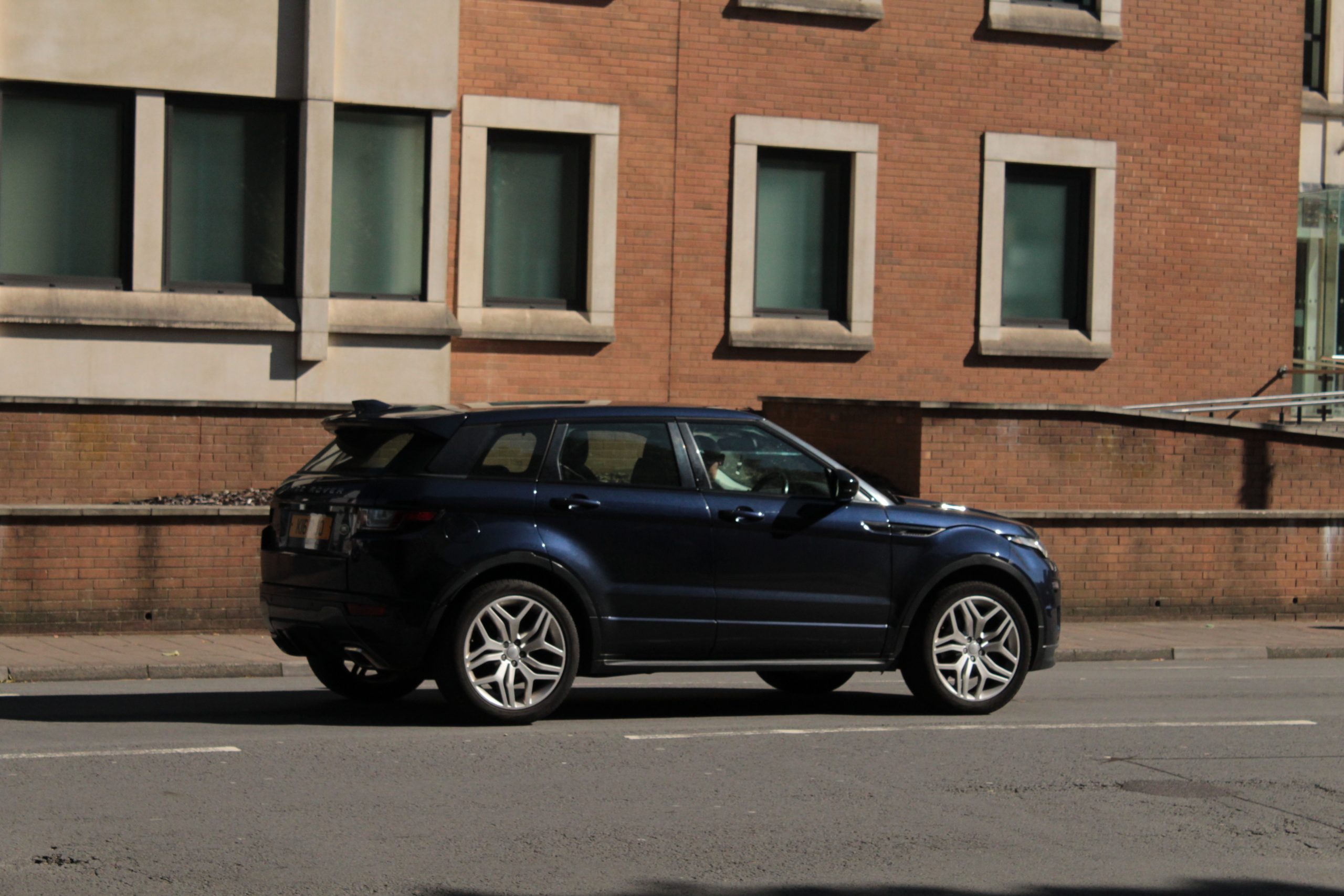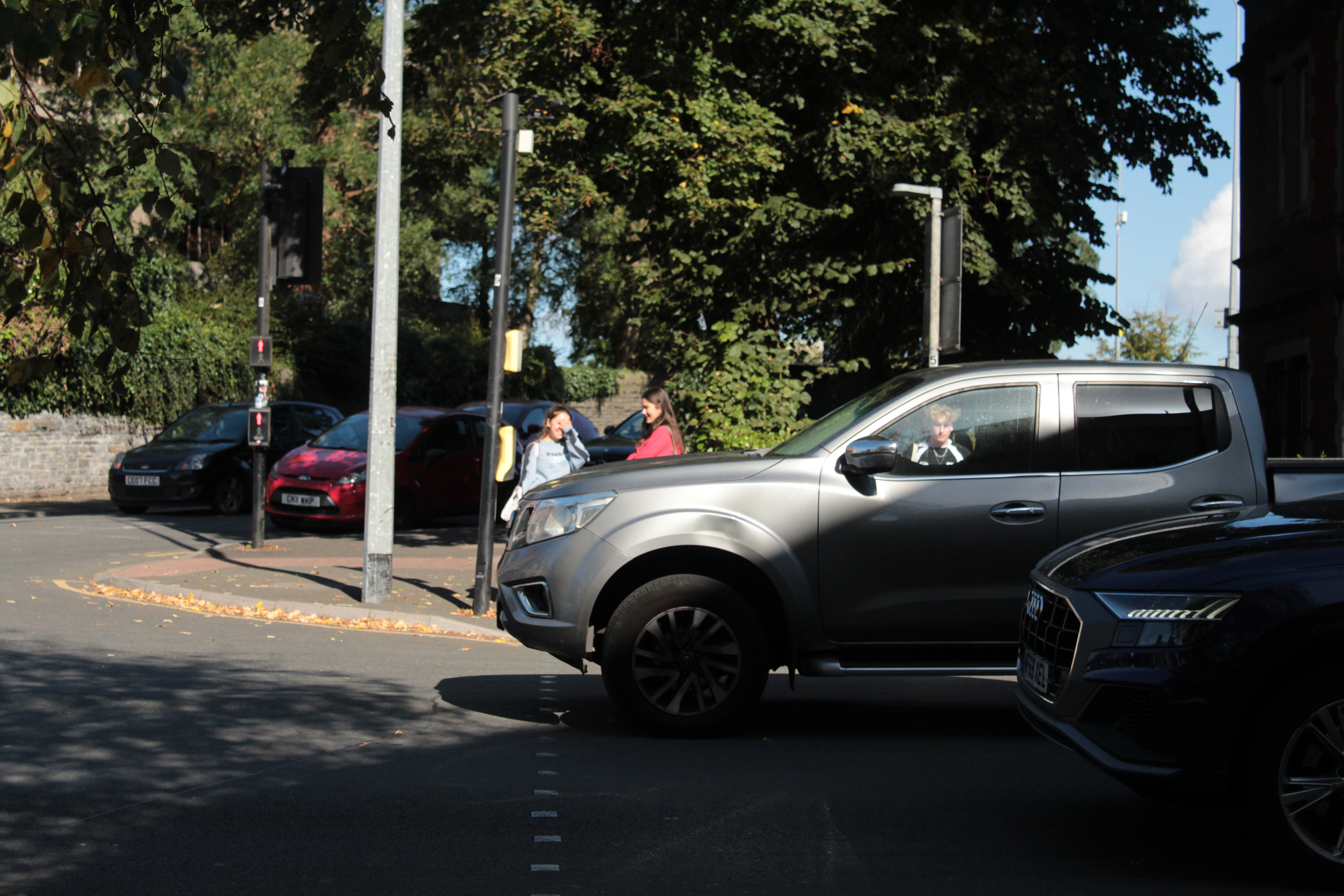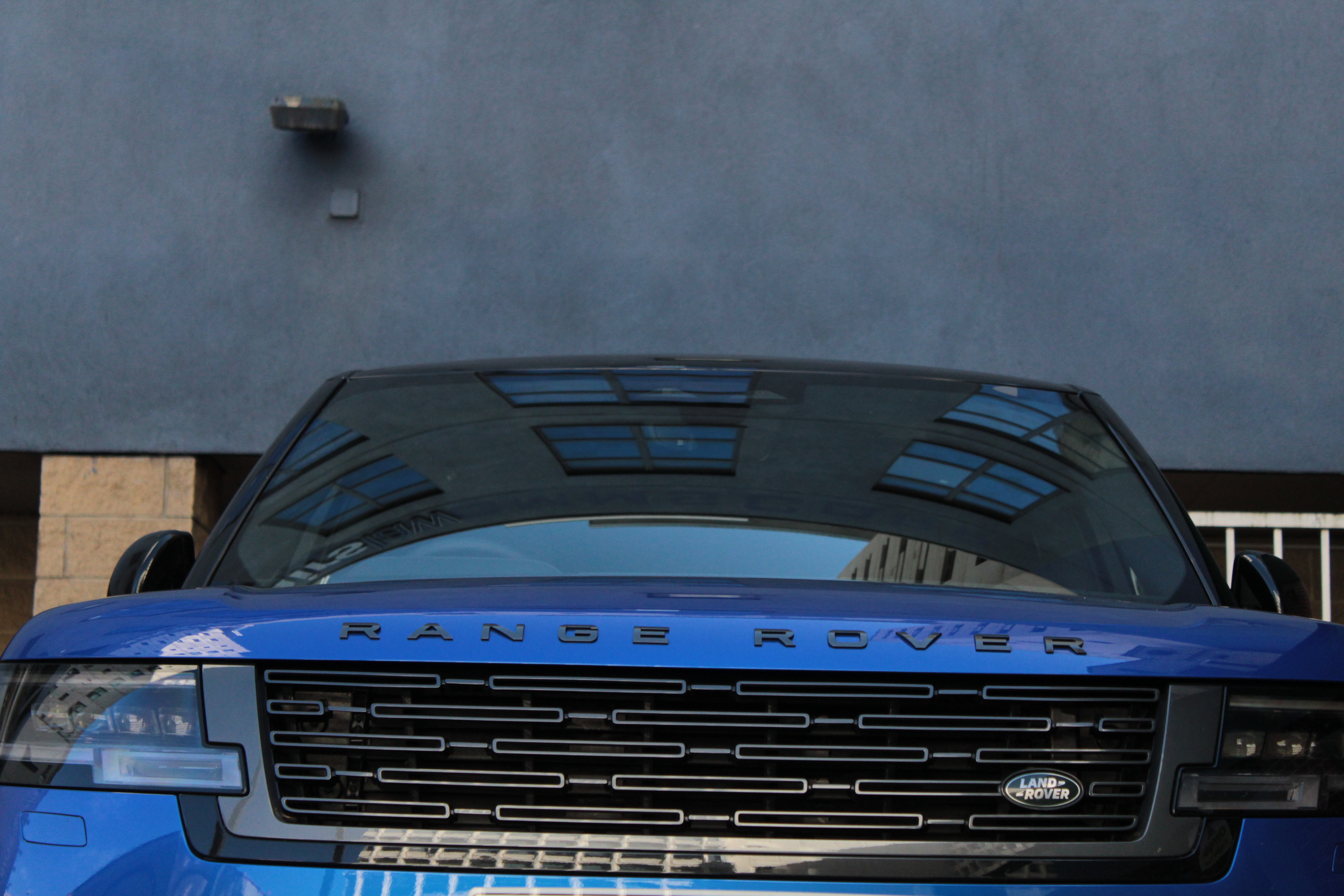
“An Epidemic” – How The Car Industry Flooded Our Streets With SUVs
In just three years time, sports utility vehicles – or SUV’s – are set to make up over two thirds of all new car registrations. They are already taking over with chilling effects on our health and natural environment. Adwitiya Pal investigates how this happened, why it matters and the multi-billion industry behind it.
Words and images by Adwitiya Pal
From Taffs Well train station, a fifteen minute walk will take you to the base of Mynydd y Garth, a 300-odd metres high hill (or a mountain, depending on who you ask) that’s become a popular destination for people enjoying an early morning stroll on the rare days the sun bids to show itself.
But around March this year, the trig point at the summit, which like many others in Wales was adorned with a stencil of Y Ddraig Goch, had been smeared with black spray paint, with the following words underneath: “This dragon has choked on SUV fumes, RIP.”
Despite the otherwise quiet and serene view from the top of y Garth, with Cardiff one way and the south Wales valleys the other, it is not impervious to the proliferation of sport utility vehicles, or SUVs. This is true whether you look at the new Pont ar Daf car park at the base of Pen y Fan, or along the streets of the capital.
Tom Morris, who studied transport and planning at Cardiff University and has worked at transport and infrastructure firm WSP, says that even the small town of Ystrad Mynach, just north of Caerphilly where he originally hails from, hasn’t been safe from what he calls an ‘SUV epidemic’.
“I visit my parents and it’s all SUVs on the roads,” he tells me. Morris is quick to fire up the Street View feature on Google Maps to prove this, and comparing the two images from 2021 and 2009, it’s evident that not only are there more cars, but they are much bigger, wider, and taller — because most of the hatchbacks and sedans, even estates have given way to SUVs. Their rise has been staggering.
By design, SUV sales have been skyrocketing, as more and more auto manufacturers try to drive their profits by selling more expensive vehicles. Over the 2010s, there was a 260 per cent increase in the number of sales of ‘dual purpose’ cars such as Range Rovers, Mazda CX-5, and Jeep Grand Cherokee, reaching almost half a million.
Right now, SUVs make up six out of every ten new car registrations in the UK, and if this trend of rising SUV sales continues, it’s projected that they could make up 75 per cent of all new car registrations by 2027.
In short, our streets have been flooded with cars that are bigger, wider, taller, and more dangerous for not just people in their immediate surroundings but also for the environment (if SUVs were a country, they would be the sixth most polluting in the world).
The first and the most obvious reason for this is through simply introducing new SUVs and phasing other models out of production. In 2000, if you went to buy an SUV, there were around 30 options to pick from. Today, there are at least 159 different models on sale from just 35 brands. The industry has also jumped on the electrification bandwagon to produce electric SUVs that are almost half as efficient as their hatchback counterparts, and of the 38 new EVs announced for release in the UK this year, 20 are SUVs.
But it’s not just that there are more SUVs, it’s that it’s increasingly difficult to buy smaller cars. Take Volvo, for instance — the Swedish manufacturer discontinued the sales of all saloons and estates in the UK last year and now only sells SUVs. Much of it is to do with smaller cars simply being less profitable, and industry insiders believe auto companies have taken the route of inducing lower sales and then citing weaker demand to replace them with light trucks and SUVs.
David Zipper from the MIT Mobility Initiative who has studied the automobile industry for decades, calls this a “prisoner’s dilemma” — a situation where consumers who may prefer smaller cars are “being pushed towards larger ones”.
The effect these larger vehicles are having in terms of road safety is clear.
The increased height of the SUVs means that visibility is reduced for the driver. Not only does it decrease handling performance and increase body roll on corners, but the taller bonnet is about 45 per cent more likely to cause fatalities in pedestrian crashes than other cars through sheer blunt force delivered to the torso and vulnerable body parts.
In an extreme case, pedestrians and cyclists are more likely to be run over by SUV drivers in a collision, as compared to any other car which would likely make impact with your lower body and throw you up on the windscreen. The threat level increases with the height difference, thus putting children at the greatest risk.
The numbers back this up as well. Every 16 minutes, a person is killed or seriously injured on British roads. A WHO report from last year found that 1.2 million lives are lost in road accidents every year, with SUVs being twice as deadly as other cars in causing death or injuries. Between 2008 and 2018, frontovers (a person getting run over by a driver who couldn’t see them) have almost doubled, with 75 percent of those incidents involving SUVs, trucks or vans.
It’s not all rosy for SUV drivers and passengers either — a person is 11 per cent more likely to die inside an SUV than a regular saloon, with studies showing that SUV drivers are lulled into a false sense of security, thus encouraging them to make more risky manoeuvres.
“We have a cultural blindspot about the harms of motoring,” says Dr Ian Walker, a traffic, transport and environmental psychologist at Swansea University. “If anything else killed a million people a year for no good reason, we would all be terrified.”
“It’s all happening in the wrong order. Through the 70s to the 90s, manufacturers went silly with oil — which, let’s be honest, is a pretty efficient fuel — and they proceeded to make bigger cars in the name of fashion accessories. But then greenwashing happened, and they started putting electric motors into these great tanks. Now, we’re stuck in a terrible cycle where cars are so heavy that you need bigger and bigger batteries and those in turn make them heavier.”
And these bigger, heavier cars are also exacerbating class inequalities in urban areas.
A 2021 report from climate charity Possible showed that three quarters of SUVs bought between 2018 and 2020 were registered to urban addresses, with six of the top 10 areas including affluent London boroughs such as Westminster, Hammersmith, and of course, Kensington and Chelsea, where one in 10 private cars registered were Range Rovers, the highest share in the UK — there’s a reason they’ve been dubbed ‘Chelsea tractors’.
The whole situation has led to an arms race. “It’s mostly about concentration of wealth. People have a lot of money and they want to show that,” says Leo Murray, co-author of the Possible report. “These vehicles are not actually performing a practical function, they’re performing a psychosocial function for their owners. Elitism is literally the sales pitch: you can look down on other road users.”
Pollution is another way in which the question of class is reflected through the proliferation of SUVs. SUVs produce 20 per cent more CO2 emissions than conventional cars on average, and 83 per cent of the SUVs being sold today are either petrol and diesel or hybrids. However, rich, gentrified areas are more likely to have green spaces to benefit their residents than the lower-income urban areas, carrying on the age-old capitalist legacy of the wealthy polluting the most but the poor having to bear the burden of it.
But conversely, the desire and a longing for the natural world is something that the SUV lobby utilises to its own advantage, cleverly marketing them as a response to urbanisation and a denial of where we live, instead posing them as tools to escape to the countryside, away from the mundanity of cities.

In fact it’s hard to overstate how key advertising, coupled with compliant governments, has been in the rise of SUVs.
This can go all the way back to when Ford drove a Model T up Ben Nevis in 1911. Around 90 years later, the American company launched its ‘No Boundaries’ campaign, linking its SUVs with outdoor activities like hiking, kayaking, rock-climbing and trail riding. Ford wasn’t alone in relaying this sort of communication. In 1998, Isuzu’s slogan read: “Put the world at the mercy of your whims,” while in 2000, Jeep announced: “Get out there and show mother nature who’s the boss.”
Most recently, Toyota landed in hot waters with the UK advertising watchdog ASA after one of its ads showed dozens of Toyota Hilux cars drive across off-road terrain, including a river, while a voiceover described the scene as “one of nature’s true spectacles”. The video continued to show the cars transition from wilderness to the contemporary by joining a road and driving through an urban area, before a lone Hilux entered a suburban home’s driveway.
Last year, ASA ruled to ban the ad in the UK after a complaint lodged by campaign group Adfree Cities, citing that it “condoned the use of vehicles in a manner that disregarded their impact on nature and the environment… they had not been prepared with a sense of responsibility to society”. Toyota argued that their campaign was aimed at those working in industries like farming and forestry who have a genuine need for such vehicles. It didn’t depict any such individuals in the ad, but said that it shouldn’t have to.
Robbie Gillet, director of Adfree Cities and an anti-SUV campaigner with Possible believes that the Toyota commercial was just one of the many ways the SUV lobby has “insidiously” used a sense of adventurism and the rugged outdoors to sell cars to urban consumers — who are instead stuck in a gridlock of their own making as roads fill up with bigger cars slowing all traffic down — when their target audience should be an entirely different demographic.
He tells voice.wales: “Advertising is a very sophisticated persuasion industry worth £36 billion in the UK. It appeals to our sense of identity, our notions of success and what it means to live the ‘good life’. Some of those mental processes work subliminally on us rather than our active, conscious daily thought, and no matter how much we’d like to try and convince ourselves, we don’t have absolute free choice in our decision making.
“The constant social signals from advertising, whether that is on billboards, on the TV, or at the beginning of a film in the cinema, implying that this car will make you an adventurous family man or this car will make you feel stronger, or this car will protect you and your family… those messages are repeated and reinforced several times a week.”
One of the reasons for this, Robbie says, is the laissez-faire approach from the government, blissfully and ignorantly hoping that the free market will naturally solve all problems. He says: “The rise of SUVs is a strong case of market failure. We are ending up with negative social and environmental outcomes through car companies pursuing profit and using advertising to persuade us to buy cars that are bigger than we need and are actively bad for us in terms of air pollution, road safety, and public space.”
What the auto industry is doing, however, isn’t anything entirely new. “While there are some differences, there are also strong parallels between the SUV and the tobacco lobby, and I think there are valuable lessons to be learnt from there,” he says.
For decades, the tobacco industry tried promoting a richer, more glamorous life through smoking. From marketing in the mass media using attractive men and women, kid-friendly characters and celebrity endorsements to heighten tobacco’s appeal to cementing cultural icons like the Marlboro Man, it sold a fantasy of a suave, independent lifestyle to the unsuspecting public.
“But unlike smoking, driving isn’t a discretionary choice. There are times when people have genuine needs for SUVs, 4x4s and pickup trucks. However, from what we’ve seen, they’re certainly using the same tactics, and often even the same PR companies to implement those strategies of deny, delay and dilute,” he says, referring to the strategy where companies deny the problem exists, then delay the need for action or new policy, and then when implemented, dilute their effectiveness.
This shouldn’t really come as a surprise, because the auto industry has long and deep-rooted ties with Big Oil — Shell, BP, Chevron, Exxon Mobil and so on, which spent years hiding crucial information and data about global warming and climate change to stonewall the implementation and then diminish the efficacy of green policies.
However, owing to the work of Adfree Cities, Possible and other campaign groups, there’s a growing sense of awareness about the impact of SUV marketing. In May, Edinburgh Council announced a ban on advertisements for “high-carbon products and services”, including SUVs, along with airlines, cruise lines and oil and gas companies. The Scottish capital followed in the heels of other UK cities which have also enacted similar bans to end unhealthy and polluting advertising, including Sheffield, Cambridge, Somerset, Coventry, Liverpool and Norwich.
“Banning the advertising and sponsorship for products such as SUVs,non electric cars, airlines, and fossil fuel companies, is actually a low cost policy solution for meeting our climate goals,” says Robbie. “We’re not talking about investing billions of pounds in new infrastructure here. We’re talking about creating tobacco-style restrictions on adverts.”
There are also calls for Westminster to introduce new width and weight limits in the zero-emission vehicles mandate set to come into effect in 2035 after the five-year postponement declared by the former prime minister. But is it really as simple as stopping all advertisements and regulating car manufacturing that is going to save us from the so-called SUV epidemic?

While it’s important for the government to set parameters for businesses to operate in, the third and the final component of this culture of cars slowly turning into tanks (or Wankpanzers, as they’re scornfully referred to by anti-SUV campaigners) is not only decisive but also perhaps something that could take the longest to undo — the economic structure of our society that shapes how our cities are designed.
Nigel Pugh, campaigns lead for Coed Cadw, The Woodland Trust as well as an environmental and road safety campaigner from Cardiff, has another explanation of why we’re seeing more and more SUVs today, and as with several things wrong in the country, it can be traced back to Thatcherism, specifically envisioning the ‘great car economy’.
Although urban sprawl — the concept of car-dependent, exclusionary development — is typically associated with American suburbs, in their book After the Car, Dennis and Urry write that upon closer inspection, most British cities don’t operate much differently, with big retail parks on the fringes of towns and separate residential areas. They claim that the current car system in the UK mirrors the American neoliberal values — segregating home, work and places of leisure and undermining the social cohesive structure of the city.
“Traditionally, streets were designed for horses and carts, and then adapted for car use,” says Nigel. “They definitely were not designed for SUVs. There shouldn’t be a need for a 4×4 vehicle of that size and capacity within an urban environment.”
“Larger cars means wider roads and bigger car parks, but that also means taking away valuable space that could be allocated to green and blue infrastructure, such as parks and water features,” says Nigel. He adds that this only further leads to a separation of urban and natural spaces, and that the SUV adverts which appeal to the users offering a return to wilderness, succeed only because the average person hasn’t got nature available at their doorstep.
“It’s more about integrating nature into your immediate space. We’re seeing more of it, but there’s still the element of social inequity in the distribution of blue-green infrastructure that we need to tackle,” he says.
There is a growing awareness about active travel and public transport to facilitate the desire to break free from this cycle of dependency on motor vehicles. It is also visible in people-led movements across the globe, which are growing in both number and force. In 2019, hundreds of people came for a vigil in Berlin calling for a ban on SUVs, after the driver of a Porsche Macan lost control of his vehicle and killed four people, including a three-year-old boy and his 64-year-old grandmother, with the district mayor also agreeing that the “armour-like” SUVs don’t belong in the city.
Similar protests have taken place in Amsterdam, Brussels as well as American cities. Meanwhile, another network of campaigners called the Tyre Extinguishers have taken it upon themselves and resorted to slashing the tyres of SUVs. Between March 2022 and July 2022, the group claimed to have deflated the tyres of 5000 SUVs in places like London, Bristol, Edinburgh as well as in Switzerland, Germany, France, Sweden, New Zealand, Canada and the USA.
And in February this year, perhaps the strongest display of this sentiment so far was on display in Paris, when residents voted to triple the parking costs of SUVs. Anna Hidalgo, the Socialist Party mayor said the move was to curb the presence of SUVs as “a form of social justice”, aimed to deliberately target the richest drivers of expensive, heavy and polluting cars who had not made any changes to their behaviour to address the climate crisis.
The referendum was closely watched by other capital cities, with London Mayor Sadiq Khan announcing he will monitor the effectiveness of the Paris rule change, while also apologising on behalf of the Greater London Authority to the family of Ella Adoo-Kissi-Debrah, who died in 2013, aged nine, as a result of the city’s polluted air.
But is it going to be enough? And is there enough conviction within this new Labour government to do so? Robbie isn’t quite so sure, saying: “At the moment, they’ve been tracking very closely to Conservative Party policy on lots of issues, including transport and climate. We’d hope to see a break from that.”
After Labour siding with the Tories in their stance against Just Stop Oil campaigners in 2022 — something which still remains unchanged to this day — an investigation by Open Democracy revealed that two of the biggest donors to Keir Starmer’s 2020 leadership campaign to replace Jeremy Corbyn were former motor industry bosses.
Nigel Pugh thinks that with the automotive industry so strong in its lobbying of the government, there would need to be a radical shift away from extractive economics, ridding ties with the colonial and imperial powers towards something called a ‘wellbeing economy’, a new framework designed to prioritise social, health, cultural, equity and environmental outcomes instead of pursuing growth. In fact, it has already been adopted as part of Wales and Scotland’s national policy.
He says: “We can save millions of pounds in bills to the NHS and roadwork costs if we just lined our roads with trees, improve our public transport systems, cut down on emissions, and elevate equality on our streets instead of driving money into the pockets of the motor industry.
“It’s in their interests to focus on selling as many cars because they want to create wealth for their shareholders. And to that end, they’ll continue building bigger and bigger cars, they’ll continue to create more emissions, build more roads, use child labour to mine lithium and cobalt for their ‘green’ electric cars, and they’ll continue to lobby the governments to perpetuate this economic model.
“But then, it’s on us to ask, ‘What has this economy given us?’ It has given us austerity, fuel poverty and food banks, then why should we rely on it and its politicians anymore, who are busy saying, ‘Look the enemy is coming in small boats’, when the real enemy is coming in yachts?


